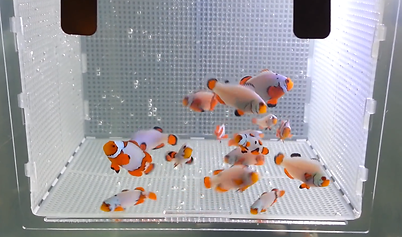Why can’t captive breeding of saltwater aquarium fish catch on?
BY SAM WEBER February 15, 2015 at 1:39 PM EDT
Courtesy to : www.pbs.org
On the outdoor lot of his beachside facility, flecked with dozens of plastic bins and tanks, biologist Syd Kraul has raised several fish species from eggs to fingerlings, including tuna, snapper, and moi, a native Hawaiian fish, for more than 30 years.
As the owner of Pacific Planktronics on the west side of the Big Island in Hawaii, Kraul has also become a focal point of a small COMMUNITY that raises popular species of tropical fish through captive breeding, similar to the way many freshwater fish are raised for life in aquariums.
But farming many species of popular aquarium fish remains an elusive feat for those hoping to enter the aquarium fish trade.
“If it was easy, anybody could do it,” Kraul said.
You see them in homes, hotels, restaurants and office lobbies around the country: Saltwater aquariums filled with colorful tropical fish to accent the atmosphere with the backdrop of the sea — even when it’s thousands of miles away.
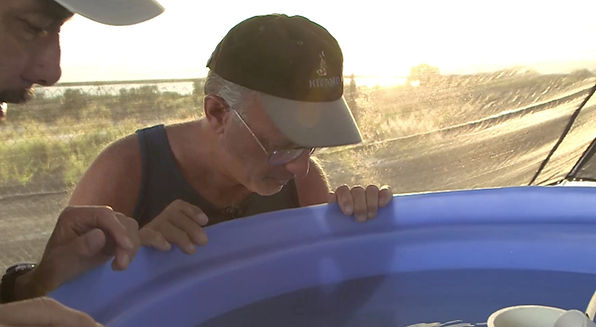
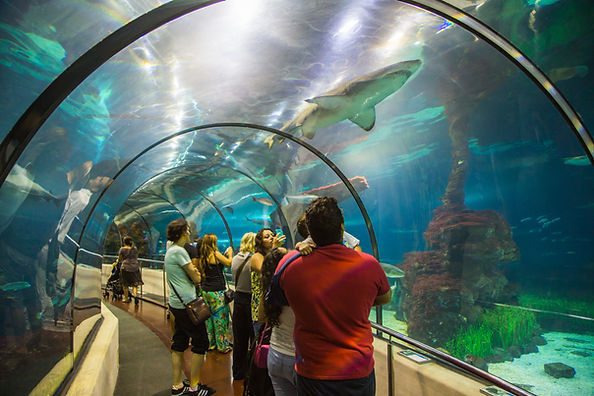
Barcelona’s underwater tunnel aquarium with sharks and visitors in aquarium tunnel underwater scene. Photo by Artur Debat / Contributor, Getty Images
Many of those fish got there by means of collectors, who pluck the gem-like fish from the wild and ship their catch to anywhere from New York to New Zealand.
The United States imports 11 million tropical fish each year, which live in an estimated two million saltwater aquariums throughout the country, and the global fish trade nets as much as $330 million annually, according to the United Nations.
But the practice has long drawn criticism from environmental activists who argue that collections damage the reef ecosystem and can deplete popular species of fish.
In some locations around the world, like in Indonesia and the Philippines, the two largest sources of ornamental fish, some collectors inject cyanide into the water to make fish sluggish so they are easier to catch.
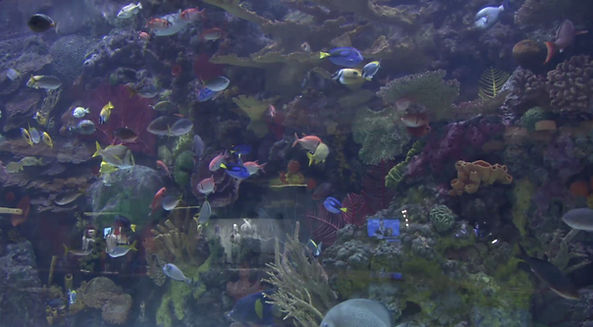
Even in Hawaii, where chemicals are strictly forbidden and the aquarium fishery is more closely managed, staunch opponents remain.
In 2013, the Hawaii Department of Land and Natural Resources established a “white list” of 40 fish species that could be taken from Hawaii’s western reefs, where collection was allowed.
But all other species of fish were off limits. So despite the high comparative COSTS of captive breeding, Kraul’s practice continues.
“I really enjoy raising baby [fish] – they’re cute,” Kraul said. “They’re really different than the adults. Everyday they change into a slightly different form.”
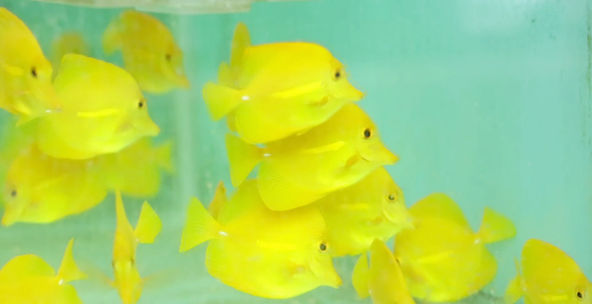
“Yellow tangs are a little bit more difficult than some of the other ones I’m raising because they’re just a little bit smaller,” Kraul said. “So that first feed is critical; getting them that right thing in the right quantity and the right quality.”
The longest anyone has been able to raise a yellow tang in captivity has been around 80 days, Kraul said. But his efforts with another popular ornamental fish have been more successful.
In 2014, Kraul raised flame angelfish, which can retail for as high as $50, in captivity.
Aquaculture experts have also had success breeding ornamental saltwater fish, including clownfish or “Nemo fish” and seahorses.
But the majority of the saltwater fish in aquariums around the world are still caught in the wild, and Kraul estimates it will be some time before captive breeding will replace wild fish collection.
“I have hopes, but I’ve had hopes for quite a few years,” Kraul said. “I just have to pick myself up, dust myself off.”
See NewsHour Weekend’s full report on the controversy surrounding Hawaii’s aquarium fish industry below:
Tropical Depression: Your Saltwater Fish Tank May Be Killing the Ocean
Scientists are struggling to raise tropical fish on farms so that fishers who now poison coral reefs to catch them will no longer be needed
Courtesy to : www.scientificamerican.com/ By Sujata Gupta | April 6, 2012
Tropical fish tanks in restaurants, hospitals and homes evoke feelings of tranquility and beauty. They even lower stress levels prior to medical procedures and encourage Alzheimer's patients to eat sufficiently. But what's good for humans may be bad for the sea.
Most tropical fish sold in pet stores come from reefs in Indonesia and the Philippines, where fishermen stun the colorful dwellers with squirts of sodium cyanide. The potent nerve toxin causes the fish to float up out of the reefs so they can be easily scooped up, but it can also injure or kill them as well as trigger coral bleaching.
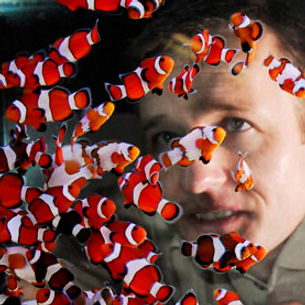
"What I find ironic is that people love the ocean. They want to keep a slice of it in their living room. But they're killing the coral reefs," says Søren Hansen a co-founder of Sea and Reef Aquaculture, LLC, in Franklin, Me., one of only a handful of tropical fish farmers in the U.S.
Why not breed the saltwater fish on farms everywhere? Most fish in freshwater tanks—which are much more common, less expensive and easier to maintain—are indeed farm-raised. But breeding saltwater fish in an industrial aquaculture facility requires re-creating the coral reef ecosystem, a technology that is just moving out of its infancy.
Improvement is urgently needed. Tropical fish sales are estimated at $200 million to $300 million a year worldwide. The U.S. imports about 11 million of the fish annually, out of 20 million sold globally. Estimates suggest that 70 to 90 percent of captured fish die before they ever reach a tank, and more perish within their first six months in captivity. "It's an overlooked industry," says Frank Baensch, a tropical fish farmer in Honolulu, adding that "If I wanted to, I could bring in species on the Red List [of endangered species] and nobody would know."
The demand for tropical fish soared in 2004, when Finding Nemo—an animated movie about father and son clown fish, Marlin and Nemo—prompted a buying frenzy. "Every kid wanted a Nemo and Dory [a regal tang that also stars in the movie] in their fish tank," recalls Andrew Rhyne, a marine biologist at Roger Williams University in Bristol, R.I.. No one thought to measure the change in the number of wild-caught fish, Rhyne says. But clown fish sales at the world's largest fish hatchery—Ocean, Reefs & Aquariums in Fort Pierce, Fla.—jumped 40 percent.
Retailers are preparing for another sales spike this fall, when Finding Nemo 3-D will be released.
Luckily, clown fish are among the few tropical fish that breed in captivity. Like most demersal fish—those that spawn on hard surfaces—parents stick around to care for their young. Demersal larvae also emerge as fully formed miniature fish, making them relatively self-sufficient. Hobbyists have been breeding clown fish by trial and error for decades. These days, Hansen says, clown fish account for about 80 percent of all tropical fish sales.
Yet almost all of the other 1,500 or more species of tropical fish sold in stores are caught live in the ocean. That is because farmers have had much more limited success in breeding pelagic fish, which account for 90 percent of all tropical species. Pelagic fish spawn and then abandon their young. Larvae lack mouths, eyes and guts and are so fragile that colliding with an air bubble could kill them.
A key challenge has been figuring out what to feed young saltwater fish. Unlike freshwater tank fish, which readily devour processed flake food, tropical fish prefer to eat their meal while it is still flapping. Luckily, breeders found that many demersal fish eat freshwater rotifers—microscopic animals that clone themselves every 24 hours and require little space. The demersal fish fare even better when the rotifers are soaked in nutrient-rich fats and proteins found in the sea.
That research has led to the successful raising of clown fish on farms. Intriguingly, the fish are also being selectively bred. At his farm in Maine, Hansen shows off his morphs, which include chocolate-brown Maine mocha Nemos, snow-white blizzard Nemos and mind-bending Picasso Nemos. Designer Nemos look cool and retail strong, Hansen says, with hobbyists paying hundreds of dollars for the newest hybrid iteration.
The tools developed to breed the clown fish have recently been successfully applied to several dozen demersal species. But breeders are not anywhere close to domesticating pelagic fish. Because pelagic fish larvae are so tiny, they can only ingest food smaller than 80 microns. (A micron is one millionth of a meter, or about 40 millionths of an inch.) Identifying and cultivating these microscopic food sources has proved difficult.
Several years ago, Baensch bred the pelagic pygmy angelfish by feeding the larvae with copepod nauplii—copepods in their earliest life stage. Besides being extremely small, copepod nauplii are packed with digestive enzymes, an essential ingredient for the gutless larvae.
Baensch initially fed the larvae wild-caught copepod nauplii from the Pacific Ocean. He now cultures the nauplii for the larvae's earliest days, but then switches to wild copepods. Copepods are a challenge, however, because unlike rotifers, they avoid crowded conditions and need time to reproduce sexually. The nauplii also outgrow pelagic larvae within a few hours.
To scale up production of pelagic larvae, farmers must learn how to breed food for them on a large scale. They are making some headway. A team in Italy shrank the copepod's space requirements by raising nauplii in a large tank and thenconcentrating them in seawater. Hansen, meanwhile, is tinkering with novel nutrition options. In unpublished work, he has cultured a species of zooplankton and successfully reared angel fish larvae on it for 15 days, the duration of his first experiment.
Hansen and others hope that identifying and rearing food for pelagic tropical fish will finally allow farmers to replace the wild-caught fish sold to retailers with species raised in captivity. That change would protect reefs from further cyanide poisoning. "Aquaculture, the way I see it, is the future," says Gayatri Lilley, founder of theIndonesian Nature Foundation, a group dedicated to developing sustainable fisheries in Indonesia. "But [currently] the biology of these reef fish remains too complicated to culture all aquarium species."
Aquaculture is therefore only a partial solution. Lilley dedicates her time to training fishermen to use underwater nets instead of the cyanide method. But the fishermen need to know that buyers will pay a higher price for fish caught using sustainable practices.
Better monitoring of the industry is also sorely needed, such as a labeling system for all fish entering the market that would indicate how they were caught or whether they were farm raised. Right now, says Rhyne and his colleague Michael Tlusty, most tropical fish entering the market simply get coded as "marine tropical fish." That, Tlusty says, "would be like bringing in salmon, pollock and tuna and calling them all seafood."
Perseverance will be key to expanding tropical fish aquaculture. Baensch recalls an experiment in which he started with 100 trigger fish, only to have their numbers dwindle to 12 overnight. "Everything was fine," he says, "until the fish started killing each other." Trigger fish, it turns out, grow up to be highly aggressive adults. But work in clown fish suggests that innate tendencies can be bred out during the domestication process—which can also lead to better pets. Back at his farm, Hansen shows me a tank filled with hundreds of clown fish. They would never school like this in the ocean, he says, adding: "Wild-caught fish come in skittish. They won't eat. They hide in a corner. My fish are used to the captive environment. They'll eat anything you throw at them. They're bulletproof."
To protect Oceans and tropical seas , Try to start your next aquarium with Captive-bred fish ....
Here is a list of these fish :
The Kaudern's Cardinal, also known as the Banggai Cardinalfish or Longfin Cardinalfish, is silver highlighted by black stripes and white spots on the body and long, elegant fins. These fish are bred in and reared in Indonesia and Asia and are hardier than their wild harvested counterparts.
A 30 gallon or larger aquarium with a cave and peaceful tank mates is ideal for this slow and methodical swimmer. Due to its aggressive behavior towards conspecifics, it should not be kept in large groups, though they do like to have a few other Cardinalfish around.
The Kaudern's Cardinal is relatively easy to breed in the aquarium setting. Once spawning has occurred, the male carries the eggs in his mouth to protect them.
The Kaudern's Cardinal should be fed a well balanced diet of meaty foods such as feeder shrimp, marine flesh,bloodworms, and depending on its size, live feeder fish.
Approximate Purchase Size: Small: 1/2" to 3/4" Medium: 7/8" to 1"
1-Kaudern's Cardinalfish
Pterapogon kauderni :
Minimum Tank Size: 30 gallons
Care Level: Easy
Temperament: Semi-aggressive
Reef Compatible: Yes
Water Conditions: 72-78° F, dKH 8-12, pH 8.1-8.4, sg 1.020-1.025
Max. Size: 3"
Color Form: Black, White
Diet: Carnivore
Compatibility: View Chart
Origin: Captive-Bred - Asia
Family: Apogonidae
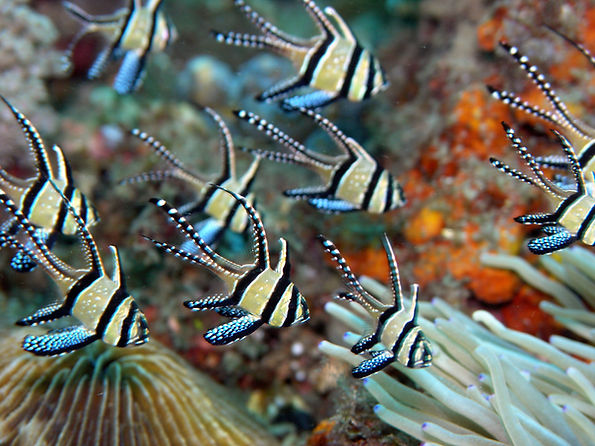
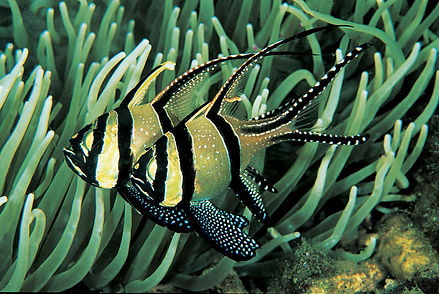
The Pajama Cardinalfish is a rainbow of playful colors. It has a greenish-yellow face, bright orange eyes, and a silver-based body dressed with a bold black scalar margin and a posterior dotted with orange polka-dots. Though its bold coloration may stand out, Sphaeramia nematopterahas a peaceful nature that lets it blend perfectly into any community saltwater aquarium.
For the best care, the Pajama Cardinalfish should be kept in small schools in suitably sized aquariums of at least 30 gallons. Because the Pajama Cardinalfish is a slow and methodical swimmer, it should be housed with peaceful tankmates and offered a plethora of hiding places amongst rockwork or plants. Most Pajama Cardinalfish will tend to hide in sea grass or other plants. Some may also camouflage themselves against long spined sea urchins.
Like many other schooling fish, the Pajama Cardinalfish will form a strict hierarchy when kept in small groups within the aquarium. However, unlike some social fish, this member of the Apogonidae family does not use aggression to exert dominance over other cardinalfish.
The Pajama Cardinalfish requires a well balanced diet of meaty foods such as feeder shrimp, flake foods, pellet foods, marine flesh, bloodworms, and depending on its size, live feeder fish.
Approximate Purchase Size: Small: 3/4" to 1-1/4" Medium: 1-1/4" to 2-1/4"
2-Pajama Cardinalfish
Sphaeramia nematoptera
Minimum Tank Size: 30 gallons
Care Level: Easy
Temperament: Peaceful
Reef Compatible: Yes
Water Conditions: 72-78° F, dKH 8-12, pH 8.1-8.4, sg 1.020-1.025
Max. Size: 3½"
Color Form: Green, White
Diet: Carnivore
Compatibility: View Chart
Origin: Fiji, Indonesia, Sri Lanka
Family: Apogonidae
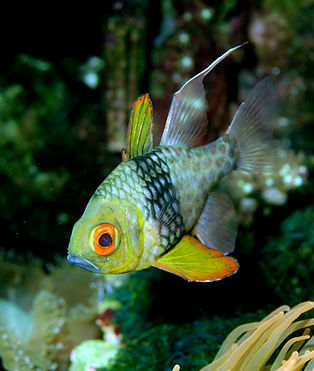
The Captive-Bred Longspine Cardinalfish comes from the reefs of the Indian Ocean, and has a long slender shape and is mostly transparent in color. The transparent color is offset by many markings and spots of both iridescent blue and yellow. The Large black eyes of this fish are outlined in iridescent blue like the markings on both the fins and body. The Captive-Bred Longspine Cardinalfish has a unique advantage over wild-harvested species. They are hardier and more accustomed to conditions found in home aquariums. Therefore, it makes a great choice for novices and seasoned aquarists alike.
A 10-gallon or larger aquarium with a cave and peaceful tank mates is suitable for this slow and methodical swimmer. It tends to hide in sea grass or other plants, or may use long spined urchins for camouflage. If a larger aquarium is available, it will handle a small group of this species. As a group, they will establish a strict hierarchy without aggressiveness.
The Captive-Bred Longspine Cardinalfish requires a well-balanced diet of meaty foods such as feeder shrimp, flake foods, pellet foods, marine flesh, bloodworms, and depending on its size, live feeder fish.
Approximate Purchase Size: Small: 1" to 2"; Medium: 2" to 3"
3-Longspine Cardinalfish
Zoramia leptacantha
Minimum Tank Size: 10 gallons
Care Level: Easy
Temperament: Peaceful
Reef Compatible: Yes
Water Conditions: 72-78° F, dKH 8-12, pH 8.1-8.4, sg 1.022-1.025
Max. Size: 2½"
Color Form: Blue, Clear, Yellow
Diet: Carnivore
Compatibility: View Chart
Origin: Captive-Bred
Family: Apogonidae
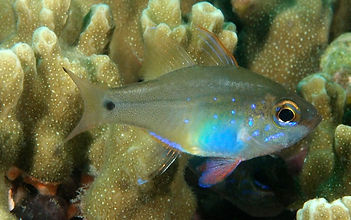
The Captive-Bred Yellowstriped Cardinalfish comes from the reefs of Fiji or Indonesia. They have a long slender shape and are an orange/red with gold color. The large black and yellow eye are offset by a black spot near the tail which confuses possible predators which way the fish is facing.
The Captive-Bred Yellowstriped Cardinalfish has a unique advantage over wild-harvested species. They are hardier and more accustomed to conditions found in home aquariums. Therefore, it makes a great choice for novices and seasoned aquarists alike.
A 10-gallon or larger aquarium with a cave and peaceful tank mates is suitable for this slow and methodical swimmer. It tends to hide in sea grass or other plants, or may use long spined urchins for camouflage. If a larger aquarium is available, it will handle a small group of this species. As a group, they will establish a strict hierarchy without aggressiveness.
The Captive-Bred Yellowstriped Cardinalfish requires a well-balanced diet of meaty foods such as feeder shrimp, flake foods, pellet foods, marine flesh, bloodworms, and depending on its size, live feeder fish.
Approximate Purchase Size: Small: 3/4" to 1-1/2"; Medium: 1-1/2" to 2"; Large: 2" to 2-1/2"
4-Yellowstriped Cardinalfish
Ostorhinchus cyanosoma
Minimum Tank Size: 10 gallons
Care Level: Easy
Temperament: Peaceful
Reef Compatible: Yes
Water Conditions: 72-78° F, dKH 8-12, pH 8.1-8.4, sg 1.020-1.025
Max. Size: 2½"
Color Form: Black, Orange, Yellow
Diet: Carnivore
Compatibility: View Chart
Origin: Captive-Bred
Family: Apogonidae
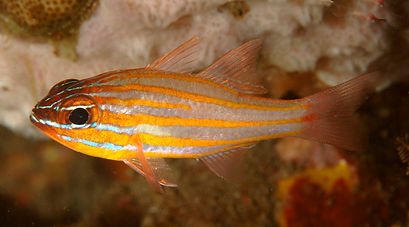
-Red Saddle Clownfish
Amphiprion ephippium
( Similar to above )
-Galaxy Clarkii Clownfish
Amphiprion clarkii
( Similar to above )
-Pearl Eye Clarkii Clownfish Amphiprion clarkii
( Similar to above )
-Semi Picasso Percula Clownfish, Amphiprion percula
( Similar to above )
-Midnight Ocellaris Clownfish
Amphiprion ocellaris var.
( Similar to above )
-Snowflake Ocellaris Clownfish
Amphiprion ocellaris
( Similar to above )
-Black Ice Ocellaris Clownfish
Amphiprion ocellaris
( Similar to above )
-Black & White Ocellaris Clownfish,
Amphiprion ocellaris var.
( Similar to above )
The Ocellaris Clownfish may be one of the aquarium industry's most popular marine fish. Its beautiful orange body dressed with white bands outlined in black instantly distinguishes the Ocellaris Clownfish. This member of the Pomacentridae family is an excellent addition to almost any saltwater aquarium system. What makes this specific variety even more appealing to aquarists is the fact that each Ocellaris Clownfish is captive-bred to help protect the fragile reef environments of the world.
The Captive-Bred Ocellaris Clownfish has other unique advantages over wild-harvested species. For one, the Captive-Bred Ocellaris Clownfish is very hardy and more accustomed to conditions found in home aquariums. Therefore, it makes a great choice for novices and seasoned aquarists alike. The Captive-Bred Ocellaris Clownfish can also be kept with a variety of other captive-bred clownfish, if introduced into the aquarium at the same time.
The Captive-Bred Ocellaris Clownfish is also easy to breed in the home aquarium. The females will be the largest of the pair and the two fish will usually stay close to each other in the aquarium. The Captive-Bred Ocellaris Clownfish is an egg layer and will deposit the eggs on a flat surface and defend the eggs from other tankmates. The eggs will normally hatch in 6-11 days depending on the water temperature. The fry must be reared in a separate aquarium on a diet of rotifers followed by baby brine shrimp.
The Captive-Bred Ocellaris Clownfish is also known as the False Percula Clownfish, False Clown Anemonefish, and Anemone Demoiselle. This fish is sometimes sold as the Percula Clown, even though it is not. The color pattern is very similar, but it is not as bright orange. The Captive-Bred Ocellaris is usually significantly lighter in coloration and is often missing one or more stripes. It may also have non-symmetrical stripes on the sides of its body, making the Captive-Bred Ocellaris Clownfish unusual and appealing to most hobbyists. The coloration of these fish will darken to a nice solid orange with age.
This Clownfish is an aggressive eater. It will accept most meaty foods and frozen herbivore preparations.
Approximate Purchase Size: Small: 3/4" to 1-1/4" Medium: 1-1/4" to 1-3/4"; Large: 1-3/4" to 3"
-Ocellaris Clownfish
Amphiprion ocellaris
Minimum Tank Size: 20 gallons
Care Level: Easy
Temperament: Peaceful
Reef Compatible: Yes
Water Conditions: 72-78° F, dKH 8-12, pH 8.1-8.4, sg 1.020-1.025
Max. Size: 3"
Color Form: Black, Orange, White
Diet: Omnivore
Compatibility: View Chart
Origin: Captive-Bred - Africa, Captive-Bred - USA
Family: Pomacentridae
5- Clownfish :

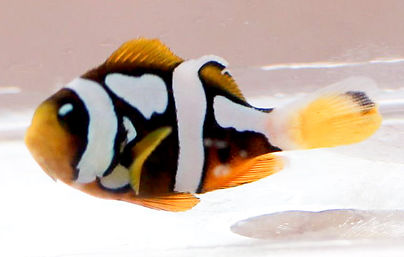
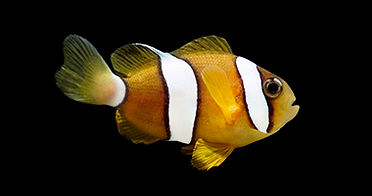


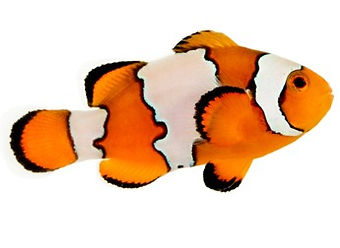

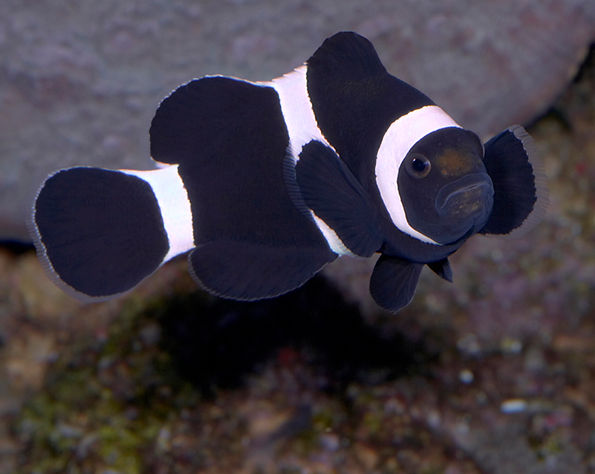
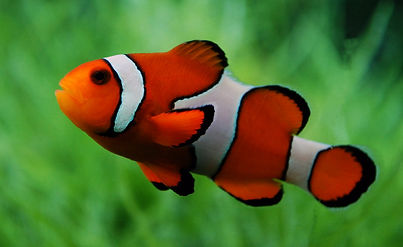
- True Percula Clownfish, Captive-Bred(Amphiprion percula)( Similar to above )
- Maroon Clownfish, Captive-Bred (Premnas biaculeatus)( Similar to above )
- Clarkii Clownfish, Captive-Bred (Amphiprion clarkii)( Similar to above )
- Cinnamon Clownfish, Captive-Bred(Amphiprion melanopus)( Similar to above )
- Tomato Clownfish, Captive-Bred(Amphiprion frenatus)
( Similar to above )
-Two Banded Clownfish, Captive-Bred(Amphiprion bicinctus)
( Similar to above )
- Black Saddleback Clownfish, Captive-Bred (Amphiprion polymnus)
( Similar to above )
- Saddleback Clownfish, Captive-Bred(Amphiprion polymnus)
( Similar to above )
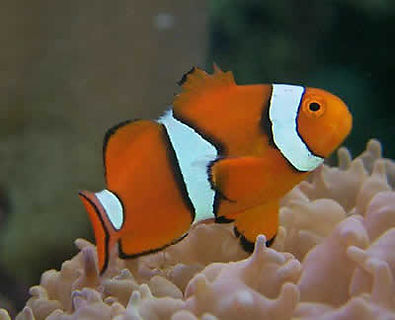
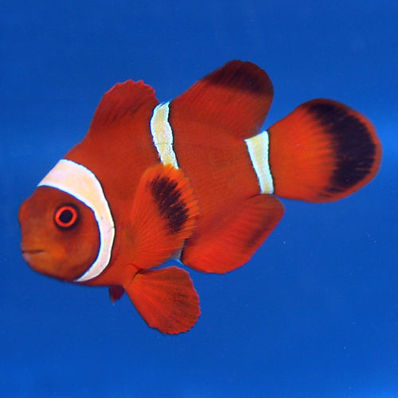
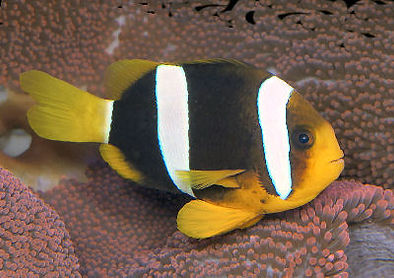
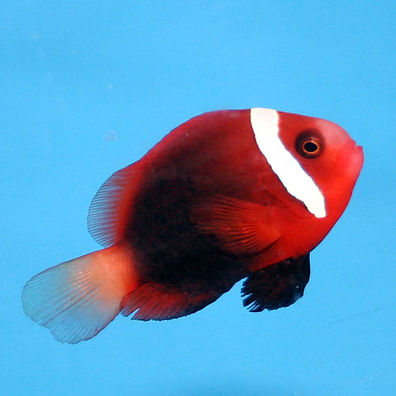
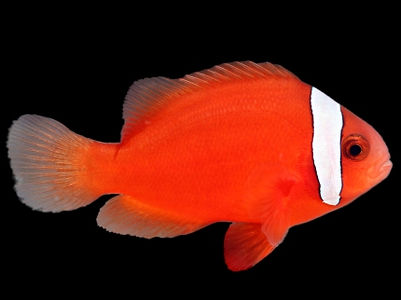
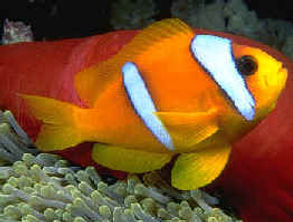

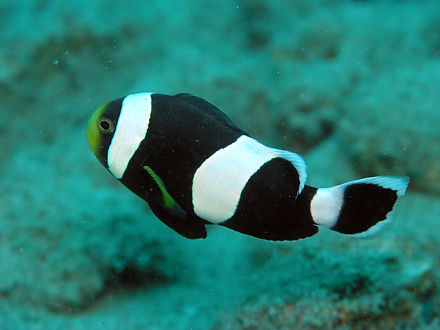
6-Neon Blue Goby
Elactinus oceanops
Minimum Tank Size: 10 gallons
Care Level: Easy
Temperament: Peaceful
Reef Compatible: Yes
Water Conditions: 72-78° F, dKH 8-12,
pH 8.1-8.4, sg 1.020-1.025
Max. Size: 2"
Color Form: Black, Blue
Diet: Carnivore
Compatibility: View Chart
Origin: Captive-Bred - USA
Family: Gobiidae
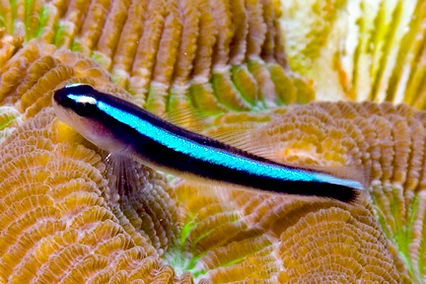
The Palau Captive-Bred Court Jester Goby, also referred to as the Rainford's Goby, or Old Glory, was first discovered in the Western Pacific in 1940 by Whitely and gets its name from its brightly colored body. The body is green and blue with horizontal orange stripes running the entire length of the body. The Captive-Bred Court Jester Goby is very timid and peaceful and is a great addition to the reef or fish only aquarium.
The Captive-Bred Court Jester Goby has a unique advantage over wild-harvested species. They are hardier and more accustomed to conditions found in home aquariums. Therefore, it makes a great choice for novices and seasoned aquarists alike.
It should be kept in a 10 gallon or larger aquarium that is well-established and has live rock and sand on which the fish can graze. It is best to keep only one of this species in an aquarium, unless the tank is large with an abundance of hiding places. It is rarely aggressive towards other species.
The diet should consist of filamentous algae, small crustaceans, such as live and frozen brine shrimp, mysis shrimp.
Approximate Purchase Size: Small: 3/4" to 1-1/4"; Medium: 1-1/4" to 2-1/4";
7-Court Jester Goby
Koumansetta rainfordi
Minimum Tank Size: 10 gallons
Care Level: Moderate
Temperament: Peaceful
Reef Compatible: Yes
Water Conditions: 72-78° F, dKH 8-12,
pH 8.1-8.4, sg 1.020-1.025
Max. Size: 3"
Color Form: Blue, Green, Orange
Diet: Omnivore
Compatibility: View Chart
Origin: Captive-Bred, Palau
Family: Gobiidae
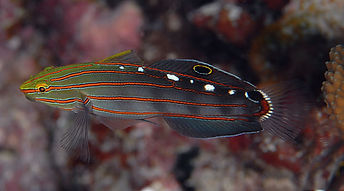
The Captive-Bred Orchid Dottyback, also known as the Fridman's Dottyback, or Fridman's Pseudochromis is an excellent addition to most reef tanks. This gorgeous lavender colored fish has a wonderful personality in the aquarium and will surely become the aquarium favorite. The Orchid Dottybacks are found only in the Red Sea. They can be found in colonies near ledges, where they can dart in and out to feed on the passing zooplankton.
A 30 gallon or larger aquarium with numerous hiding places should be provided. It will tend to swim in the open after it has become acclimated to its new environment. It may occasionally chase smaller fish but will defend its hiding places from intruders. It will prey on pests such as small mantis shrimp and bristleworms, making this fish ideal for the reef aquarium. If more than one Pseudochromis will be maintained together in the aquarium, it is important to add them at the same time.
The Captive-Bred Orchid Dottyback should be fed a varied diet consisting of foods specifically designed for carnivores. If kept in a reef aquarium, the Captive-Bred Orchid Dottyback should be fed once per day.
Approximate Purchase Size: Small: 1" to 1-3/4" Medium: 1-3/4" to 2-1/2"
8-Orchid Dottyback
Pseudochromis fridmani
Minimum Tank Size: 30 gallons
Care Level: Easy
Temperament: Semi-aggressive
Reef Compatible: Yes
Water Conditions: 72-78° F, dKH 8-12, pH 8.1-8.4, sg 1.020-1.025
Max. Size: 3"
Color Form: Purple, Red
Diet: Carnivore
Compatibility: View Chart
Origin: Captive-Bred - USA
Family: Pseudochromidae
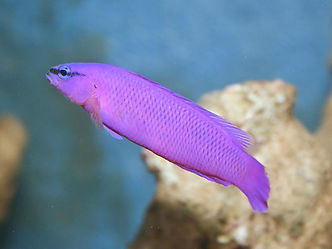
9- Indigo Dottyback,
Pseudochromis fridmani x sankeyi
Minimum Tank Size: 30 gallons
Care Level: Easy
Temperament: Semi-aggressive
Reef Compatible: Yes
Water Conditions: 72-78° F, dKH 8-12, pH 8.1-8.4, sg 1.020-1.025
Max. Size: 3"
Color Form: Black, Blue
Diet: Carnivore
Compatibility: View Chart
Origin: Captive-Bred - USA
Family: Pseudochromidae
The Indigo Dottyback is a striking Pseudochromis that boasts a respected lineage of two marine aquarium favorites. The Indigo Dottyback is a hybrid between the Orchid Dottyback (Pseudochromis fridmani) and the Striped Dottyback (Pseudochromis sankeyi). The resulting offspring are beautifully colored fish sporting a soothing indigo coloration. At first glance, the Indigo Dottyback looks as though it takes after the brilliantly-colored Orchid Dottyback (appearing more like an exciting color morph of the Orchid Dottyback rather than a hybrid). However, upon closer examination, traits of the Striped Dottyback can be seen. Though the dominant stripe running parallel to the lateral line is greatly subdued, the Indigo Dottyback exhibits the same dark stripe that runs the entire ventral length of the Striped Dottyback. The unique indigo coloration and the dark graphic stripe add distinction to this wonderful captive-bred hybrid. LiveAquaria.com is proud to offer the Indigo Dottyback as another choice in our growing selection of aquacultured and captive-bred aquatic life.
The ideal setup for the Indigo Dottyback will be an established saltwater aquarium of at least 30 gallons in size aquascaped liberally with generous amounts of live rock. Create ample crevices and caves for the Indigo Dottyback to explore, claim or seek refuge. Similar to other Dottyback species, it is recommended to house the Indigo Dottyback singly unless the aquarium is very large. It is reputed that the mild-mannered Indigo Dottyback poses minimal threat to crustaceans and ornamental shrimp making it an excellent candidate for reef aquariums.
The diet of the Indigo Dottyback consists of meaty foods including vitamin-enriched brine and mysis shrimp as well as other prepared frozen foods.
Approximate Purchase Size: Small: 1" to 1-3/4"; Medium: 1-3/4" to 2-1/2"
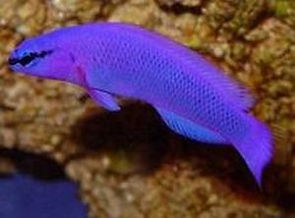
10-Kuda Seahorse,
(Australia) (Hippocampus kuda)
Minimum Tank Size: 30 gallons
Care Level: Moderate
Temperament: Peaceful
Reef Compatible: Yes
Water Conditions: 72-78° F, dKH 8-12, pH 8.1-8.4, sg 1.020-1.025
Max. Size: 6"
Color Form: Black, Clear, Tan, Yellow
Diet: Carnivore
Compatibility: View Chart
Origin: Captive-Bred
Family: Syngnathidae
The Captive-Bred Kuda Seahorse is a moderately sized seahorse and is also known as the Spotted Seahorse. This species ranges in color from black to yellow. Some individuals may have spots or a darker band or bars on their body.
These social fish thrive when kept as a mated pair or in small groups in a species-only aquarium. A 30 gallon aquarium is sufficient for a single pair. Add 10 gallons to the size of the aquarium for each additional pair. Spray bars may be used to create gentle flow while eliminating stagnant areas in the aquarium. Seahorses are not strong swimmers, preferring to use their prehensile tails to hitch to branching live rock, algae, or artificial decorations. Seahorses are less likely to contract Vibrio bacterial infections if the temperature is not allowed to exceed 74°F. This is particularly important if the aquarium contains other species of Syngnathids. It is also necessary to remove detritus and uneaten food daily. Calcium and alkalinity levels must be monitored and maintained to keep their bony plates healthy.
They may be kept with small, shy fish such as smallgobies, pipefish, dragonets, and firefish. But aggressive, territorial, or fast-moving fish do not make good companions. Seahorses can be harmed by anemones and corals with stinging tentacles or corals that are large enough to consume them, such as brain corals. While sea fans, Acropora corals, and other branching corals may be safe for seahorses, they can be irritated or damaged by a seahorse that continually hitches to them. Crabs and clams may pinch a seahorse causing a wound that could lead to secondary infections. Small ornamental crustaceans may be consumed by the seahorses.
Avoid fish that will out-compete the seahorse for food. These captive-bred seahorses are accustomed to frozen Mysis shrimp, making them a smart alternative to their wild-caught counterparts. They will also feed upon amphipods and other small crustaceans found in live rock. They will also accept vitamin-enriched adult brine shrimp, but this should not make up a majority of their diet. They are slow, deliberate feeders and prefer two or more small feedings per day.
Seahorses are probably the most recognizable fish in the world due to their unusual appearance and habits. They are very social, curious fish that are fun to watch while they interact with their surroundings, each other, and even their owners.
Approximate Purchase Size: Small: 2” to 2-1/2”; Medium: 2-1/2” to 3”; Large: 3” to 4”

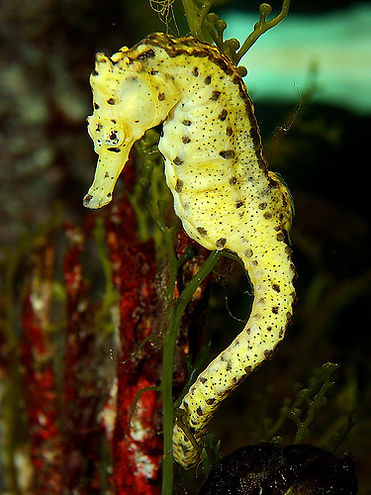

11-Captive-Bred Porkfish
Anisotremus virginicus
Minimum Tank Size: 180 gallons
Care Level: Easy
Temperament: Peaceful
Reef Compatible: No
Water Conditions: 72-78° F, dKH 8-12, pH 8.1-8.4, sg 1.020-1.025
Max. Size: 1'
Color Form: Black, Orange, White, Yellow
Diet: Omnivore
Origin: Captive-Bred - USA
Family: Haemulidae
We are pleased to offer the Rising Tide Captive-Bred Porkfish, which originates from the Western Atlantic. Displaying a yellow head and fins accenting a silver-gray base with two black vertical stripes. They are a peaceful fish that make a wonderful addition to a peaceful saltwater fish only aquarium. What makes this fish even more appealing to aquarists is the fact that each Porkfish is captive-bred to help protect the fragile reef environments of the world.
The Captive-Bred Porkfish has other unique advantages over wild-harvested species. For one, the Captive-Bred Porkfish is very hardy and more accustomed to conditions found in home aquariums. Therefore, it makes a great choice for novices and seasoned aquarists alike.
A 180 gallon or larger aquarium with abundant open space to swim is required. Several Porkfish, in a school, would be suitable if there is enough room in the aquarium. In the wild these fish prefer to hover around reefs and prefers a cave or ledge for refuge. These fish have been known to occasionally pick parasites from the bodies of tank mates. Do not house the Captive-Bred Porkfish with aggressive species, and adults should be the first to be introduced into a community tank. They are not a good candidate for a reef aquarium, as they will readily consume any crabs, snails, shrimp and starfish.
The Captive-Bred Porkfish diet consists of a variety of meaty foods such as chopped shrimp, marine fish flesh, and prepared frozen food for carnivores, and vegetable matter.
These fish will arrive in their juvenile coloration. As the Captive-Bred Porkfish adjusts to the aquarium and matures, the adult coloration will be visible when the fish is approximately 4-5" in length.
Approximate Purchase Size: Small: 1-1/2" to 2-1/4”; Medium: 2-1/4" to 3-1/2"


